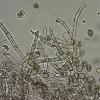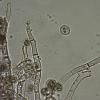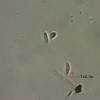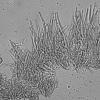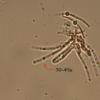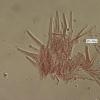
12-11-2025 09:25
 Viktorie Halasu
Viktorie Halasu
Hello, I need help with a pale terrestric Pseudom

11-11-2025 20:16
Bohan JiaHi, lastly I have found these tiny yellow decayin

09-11-2025 13:20
Hello.A tiny ascomycete, appearing as erupting gra

08-11-2025 00:29
 Francois Guay
Francois Guay
I found this species in Quebec, Canada, on herbace

Dear forum,
On the bark of Larix I found some some small cup-shaped apothecia 0.2-0.25mm on a copious whitish cobwebby subiculum. The hyphae showed some warts. Clamps were not present. Among the hyphae I found a lot of conidiospores of about 16x11µ.
The asci were uni- to irregularly biseriate and measured about 46x6µ. Spores were hyaline, allantoid and measured 7x2.5µ. The cylindrical paraphyses showed some small drops. Hairs were smooth, 20-30µ, and ended in a pointed tip.
Could this be Hyaloscypha fuckelii on hyphae of an anamorf fungus or belong anamorph and telemorph to the same species?

The broad hyphae are another fungus.

definitely not. I see in some hairs an apical minute glassy knob, and that occurs sometimes in Hyaloscypha.
Zotto

Thank you for the suggestion Simon.I will try the anamorph key in Bernicchia
Marc

Good evening Hans-Otto
You are right about the vacuolar bodies although they are not always present.
Is Psilachnum the only choice with VB's?


Looks very much like a Hyaloscypha to me. Haven't seen Psilachnum-droplet often in Hyaloscypha, but occasionally yes, so not impossible. I think Larix is not that well known as a substrate (or maybe Raitviir knew it?). Most Hyaloscyphas show dextrinoid reactions, have you tried that? Works for dried material as well. Can't recall Psilachnums having dextrinoid reactions.
Timo



:-), yep, hairs/excipula should turn something close to maroon / red wine / Earl Grey (no milk) (=dextrinoid). If something is turning blue only then you call it amyloid. But I'll take it that you just very much confirmed it as an Hyaloscypha.
T




